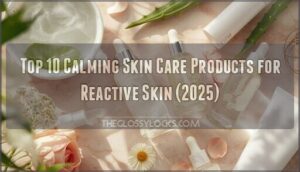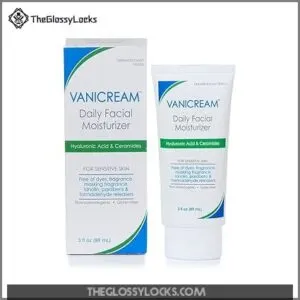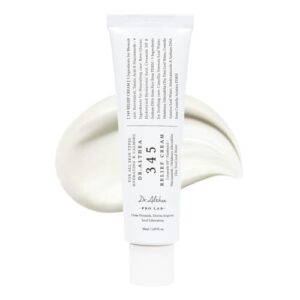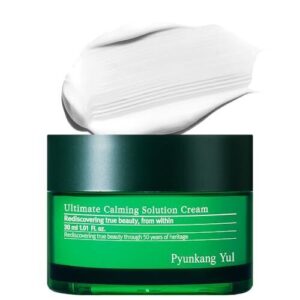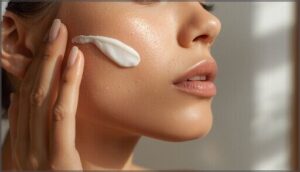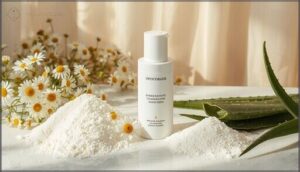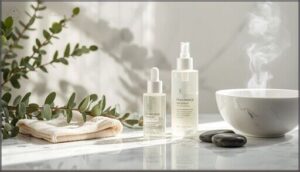This site is supported by our readers. We may earn a commission, at no cost to you, if you purchase through links.
Your face flushes after applying a supposedly gentle moisturizer. A whiff of perfume triggers instant stinging. Even water sometimes feels like sandpaper. If this sounds familiar, you’re dealing with reactive skin—a condition affecting up to 70% of people whose weakened skin barriers can’t effectively block irritants or lock in moisture.
The frustrating part? Most traditional skincare only makes things worse, loading formulas with fragrances and preservatives that account for nearly half of all cosmetic allergic reactions.
The good news is that calming skin care for reactive skin has evolved dramatically, with research-backed ingredients like ceramides and centella asiatica now proven to rebuild barrier function and reduce inflammation within weeks. The right products don’t just mask symptoms—they address the underlying vulnerability that makes your skin overreact in the first place.
Table Of Contents
- Key Takeaways
- Why Calming Skin Care Matters for Reactive Skin
- Key Ingredients for Soothing Sensitive Skin
- Top 10 Calming Skin Care Products for Reactive Skin
- 1. La Roche-Posay Double Repair Moisturizer
- 2. Vanicream Daily Facial Moisturizer Sensitive Skin
- 3. Avène Hydrance Aqua Cream Antioxidant Protection
- 4. iS Clinical Reparative Moisture Emulsion
- 5. Dr Althea Relief Cream Moisturizer
- 6. Reactive Skin Solutions Soothing Moisturizer
- 7. Centella Cica Redness Relief Serum
- 8. Pyunkang Yul Calming Solution Cream
- 9. Raya Probiotic Calming Face Cream
- 10. Beauty of Joseon Calming Green Tea Serum
- Daily Skincare Routine Tips for Reactive Skin
- Managing Flare-Ups and Long-Term Skin Comfort
- Frequently Asked Questions (FAQs)
- Conclusion
Key Takeaways
- Reactive skin stems from a compromised barrier that can’t block irritants or retain moisture, affecting up to 70% of people and causing immediate stinging, burning, or redness when exposed to triggers like fragrances, preservatives, or environmental stressors.
- Clinically proven ingredients like ceramides, niacinamide, and centella asiatica rebuild barrier function and reduce inflammation within weeks, with studies showing measurable improvements in hydration, redness, and skin comfort when used consistently.
- Effective reactive skin care requires avoiding common irritants—including fragrances (which cause 30–45% of cosmetic allergic reactions), harsh preservatives, sulfates, and alcohol—while sticking to fragrance-free, minimalist formulations that support rather than strip your barrier.
- Managing reactive skin long-term means building a simple routine with gentle cleansing, barrier-repairing moisturizers applied to damp skin, and mineral sunscreen, while tracking your personal triggers and seeking professional help when inflammation persists despite home care.
Why Calming Skin Care Matters for Reactive Skin
If your skin reacts to everything from new products to temperature changes, you’re dealing with reactive skin—and you’re not alone. This heightened sensitivity happens when your skin’s protective barrier is compromised, leaving it vulnerable to irritation, redness, and discomfort.
Let’s break down what reactive skin really means, what triggers it, and why understanding your skin barrier is the first step toward lasting calm.
What is Reactive Skin?
What exactly sets reactive skin apart from just sensitive skin? Reactive skin experiences sudden, intense skin reactions—tingling, burning, or visible redness—within minutes of exposure to triggers that normally wouldn’t bother most people. This clinical definition reflects barrier dysfunction and heightened nerve sensitivity.
A weakened skin barrier is often a primary cause of reactive skin. Prevalence rates show up to 70% of people report some degree of reactivity, making soothing skin irritation and treating reactive skin inflammation essential for daily comfort.
Common Triggers and Causes of Sensitivity
What triggers your reactive skin? Environmental aggressors like pollution and UV exposure drive 16% higher oxidative stress in sensitive skin, while fragrances cause 30–45% of cosmetic allergic reactions. Preservative reactions affect 29% of contact allergy cases, and psychological stress worsens flare-ups in 71% of adults. Many people experience allergic contact dermatitis from fragrances.
Genetic predisposition plays a role too—specific gene variants increase inflammation susceptibility. Understanding your personal triggers is the first step toward calmer, more comfortable skin.
The Importance of a Healthy Skin Barrier
Understanding what sparks your sensitivity matters, but your skin barrier is what determines how you respond. This protective shield regulates skin hydration and blocks irritants—when it fails, TEWL Impact increases and ceramide levels drop. Filaggrin deficiency disrupts this balance, leaving you vulnerable.
Your skin barrier determines how you respond to irritants—when it fails, moisture escapes and inflammation takes hold
A healthy skin barrier function means:
- Retaining moisture while blocking pollution and UV damage
- Maintaining ceramides that prevent dryness and eczema
- Reducing inflammation through stronger barrier defense
Compromised barriers affect up to 46% of certain populations with ulcer prevalence, making barrier support non-negotiable for sensitive skin.
Signs Your Skin Needs Calming Care
Your skin is already telling you what it needs. Nearly 38% of people with sensitive skin notice redness as their first warning sign, while texture changes like dryness or flaking affect another 34.5%. Here’s what to watch for:
| Warning Sign | What It Means |
|---|---|
| Stinging or burning after products | Product reactions—31% experience this with reactive skin |
| Redness after temperature shifts | Environmental flare-ups hit 35.7% of sensitive skin types |
| Tightness or rough patches | Texture changes signal barrier breakdown |
| Frequent discomfort episodes | 46% rate their sensitivity as moderate to severe |
When you’re seeing two or more of these patterns, your skin’s asking for calming care.
Key Ingredients for Soothing Sensitive Skin
When your skin reacts to everything, the right ingredients can make all the difference between constant irritation and real relief. Not every “calming” product actually calms—some ingredients genuinely restore your skin’s defenses, while others just add more potential triggers.
Here’s what to look for and what to skip when you’re building a routine that won’t backfire.
Ceramides for Barrier Support
Think of your skin barrier as a brick wall—when it crumbles, irritation floods in. Ceramides act as the mortar, filling gaps to lock moisture in and keep irritants out.
Clinical studies show ceramide-rich formulations reduce transepidermal water loss (TEWL) within 28 days, restoring lipid replenishment your reactive skin desperately needs.
These calming skin care products deliver measurable skin barrier support, transforming fragile skin into resilient armor.
Niacinamide’s Anti-Inflammatory Benefits
When your skin overreacts to everything, niacinamide steps in as a proven anti-inflammatory ally. Clinical usage shows cytokine suppression—specifically IL-1β, IL-6, and TNF-α—reducing skin inflammation within two weeks.
This powerhouse ingredient addresses oxidative stress while delivering barrier restoration through increased ceramide synthesis.
You’ll notice redness reduction and improved comfort as niacinamide calms sensitive skin without harsh side effects, making it essential in soothing skin care routines.
Glycerin and Skin Hydration
Unlike flashier ingredients, glycerin works quietly as a proven humectant that pulls water into your skin’s outer layers. Studies show it reduces transepidermal water loss by up to 38%, strengthening your barrier function with consistent use.
Consider these hydration benefits:
- Penetrates deeply due to its small molecular size
- Performs reliably even in low-humidity environments
- Safe concentrations of 2–10% deliver maximum moisturizing without stickiness
Most sensitive skin care products include glycerin at 3–15% for good reason.
Centella Asiatica and Other Calming Extracts
When you’re battling reactive skin, plant-based extracts offer relief backed by solid research. Centella Asiatica leads with proven anti-inflammatory power and barrier repair—studies show reduced redness in just four weeks. Market growth reflects consumer trust: the Centella cosmetics market hit $790.3 million in 2024, with clinical studies confirming safety profiles above 97% tolerability.
| Extract | Key Action Mechanisms |
|---|---|
| Centella Asiatica | Boosts collagen synthesis, reduces water loss |
| Green Tea (EGCG) | Neutralizes free radicals, calms UV damage |
| Chamomile | Accelerates epithelialization, strengthens barrier |
These calming, sensitive skin-friendly extracts work synergistically for measurable skin soothing.
Ingredients to Avoid With Reactive Skin
You wouldn’t put sandpaper on a wound—so why expose reactive skin to fragrance allergens that trigger dermatitis in up to 30% of cosmetic reactions?
Preservative reactions, sulfate irritation, and alcohol sensitivity worsen barrier dysfunction dramatically. Dye sensitization affects sensitive skin even at 0.1% concentrations.
Avoid methylisothiazolinone, SLS, denatured alcohol, and synthetic fragrances—these product ingredients increase skin irritation and undermine healing.
Top 10 Calming Skin Care Products for Reactive Skin
Finding the right products for reactive skin takes more than guessing—it requires formulations backed by dermatological research and proven calming ingredients.
The products below have been selected based on their ability to strengthen your skin barrier, reduce inflammation, and minimize irritation without unnecessary additives.
Each option caters to specific needs, from intense hydration to redness relief, so you can choose what works best for your skin’s unique triggers.
1. La Roche-Posay Double Repair Moisturizer
La Roche-Posay Toleriane Double Repair Face Moisturizer stands out for its rapid barrier repair. Clinical results show it restores your skin’s protective function in just one hour.
This lightweight formula combines ceramide-3, niacinamide, and glycerin with microbiome-balancing prebiotics, addressing both immediate comfort and long-term resilience.
Consumer reviews consistently highlight its calming effect on sensitive skin, with 86% of users reporting reduced dryness after one week. It’s fragrance-free and non-comedogenic, delivering 48-hour hydration without triggering breakouts.
Ingredient efficacy here is backed by rigorous testing across diverse skin tones.
Best For: Anyone with sensitive, dry, or reactive skin who needs fast barrier repair and long-lasting hydration without irritation.
- Restores your skin’s protective barrier in just one hour and delivers 48-hour hydration, so you get both immediate relief and lasting comfort.
- Fragrance-free, non-comedogenic formula with ceramide-3, niacinamide, and prebiotics makes it safe for sensitive skin and won’t clog pores or trigger breakouts.
- Backed by extensive clinical testing across all skin tones, with 86% of users reporting reduced dryness after just one week of use.
- Priced higher than many drugstore moisturizers, which might not fit every budget.
- Can pill slightly if you apply too much product or layer it with certain sunscreens or makeup.
- Some customers received the wrong size (100ml instead of 75ml), which points to occasional fulfillment issues.
2. Vanicream Daily Facial Moisturizer Sensitive Skin
Vanicream Daily Facial Moisturizer delivers barrier repair through five ceramide types—EOP, NG, NP, AS, and AP—which work alongside hyaluronic acid and squalane to lock in hydration levels without weighing down your skin. This fragrance-free formula absorbs quickly, making it ideal for a gentle skincare routine that won’t clog pores or trigger breakouts.
User reviews consistently praise its calming effect on reactive skin, and it holds the National Eczema Association seal. Ingredient safety concerns are minimal, though some report sensitivity to stearyl alcohol, so patch testing remains wise.
Best For: People with sensitive, reactive, or eczema-prone skin who need lightweight hydration and barrier repair without fragrances or common irritants.
- Five ceramides plus hyaluronic acid and squalane deliver serious barrier repair and moisture retention without feeling heavy or greasy.
- Holds the National Eczema Association seal and is widely recommended by dermatologists for post-procedure care and reactive skin.
- Fragrance-free, non-comedogenic formula absorbs quickly and works well under makeup or sunscreen for daily use.
- May not provide enough richness for extremely dry or mature skin types that need heavier emollients.
- Some users experience irritation from stearyl alcohol or phytosterols, so patch testing is recommended despite the gentle formulation.
- Hydration may fade throughout the day for certain users, requiring midday reapplication to maintain comfort.
3. Avène Hydrance Aqua Cream Antioxidant Protection
Avène Hydrance Aqua Cream offers antioxidant protection through provitamins C and E, which neutralize free radicals while restoring moisture balance. This aqua-gel formula is designed to absorb quickly without greasiness, making it ideal for sensitive skin.
Clinical trials demonstrate its effectiveness, with 97% of users reporting immediate comfort and 91% noticing suppler skin after three weeks. These results are supported by key ingredients like hyaluronic acid and aloe barbadensis juice, which work together to bind water and soothe reactive patches.
The product is dermatologist-recommended for its ability to provide both hydration and environmental defense. Its non-comedogenic profile ensures it won’t clog pores, making it a suitable choice for those concerned about breakouts.
Best For: People with sensitive or acne-prone skin who want lightweight daily hydration with antioxidant protection but plan to layer SPF separately.
- Absorbs fast with a refreshing aqua-gel texture that doesn’t leave skin sticky or greasy, making it perfect for layering under makeup or sunscreen.
- Clinically proven to hydrate for up to 24 hours while visibly plumping and soothing sensitive skin, with 91% of users seeing improvement in suppleness after three weeks.
- Non-comedogenic and hypoallergenic formula with antioxidants like provitamins C and E helps defend against free radicals without triggering breakouts or irritation.
- No SPF included, so you’ll need to apply a separate sunscreen for daytime protection, adding an extra step to your routine.
- The fragrance might bother people with very reactive skin or those who prefer completely scent-free products.
- Some users report a slight residue on the skin, which could feel less ideal if you’re looking for a completely invisible finish.
4. iS Clinical Reparative Moisture Emulsion
IS Clinical Reparative Moisture Emulsion earns its spot with a clinical efficacy rating of 91 out of 100. This lightweight formula combines copper tripeptide growth factors with EUK-134, a synthetic antioxidant that outperforms vitamin E in protecting against oxidative stress.
Over 70% of recent users described it as soothing for sensitive skin types. It provides sustained moisture retention exceeding eight hours while reducing trans-epidermal water loss by at least 15% after one week.
The emulsion benefits include improved skin barrier repair through hyaluronic acid and extremozymes, making it effective post-procedure for calming redness.
Best For: People with sensitive or reactive skin who need intense hydration and barrier repair, especially after cosmetic treatments or retinol use.
- Clinical-grade ingredients like copper tripeptide and EUK-134 deliver measurable antioxidant protection and help reduce visible signs of aging.
- Provides over 8 hours of hydration and cuts water loss by 15% within a week, making it genuinely effective for dry or compromised skin.
- Lightweight texture absorbs quickly without feeling greasy, and over 70% of users say it’s soothing rather than irritating.
- Expensive at $110 for 1.7 ounces, which might be tough to justify if you’re on a budget.
- Has medium irritation and comedogenic potential, so it’s not foolproof for every skin type despite being marketed for sensitive skin.
- A small percentage of users experienced allergic reactions or found it too heavy, so patch testing is smart before committing.
5. Dr Althea Relief Cream Moisturizer
Dr Althea 345 Relief Cream offers clinically proven results for calming sensitive skin, with hydration levels rising 177% after use. This fragrance-free moisturizer combines niacinamide, ceramide NP, and tea tree extract to support skin barrier repair while reducing post-inflammatory redness.
The lightweight formula absorbs quickly without greasiness, making it ideal for layering under makeup. Clinical testing documented an 8.88% improvement in comfort for reactive skin types.
Most users report visible calming of red blemishes within weeks, though some find the tube packaging difficult to empty completely.
Best For: People with sensitive, acne-prone, or post-treatment skin who need a fragrance-free moisturizer that calms redness and supports barrier repair without clogging pores.
- Clinically proven to boost hydration by 177% and reduce irritation, with fast-absorbing texture that works under makeup
- Contains barrier-repairing ingredients like ceramide NP and niacinamide that visibly calm post-acne redness within weeks
- Vegan, fragrance-free, and non-comedogenic formula safe for reactive skin, eczema, and rosacea
- Tube packaging makes it hard to squeeze out the last bit of product
- Higher price point compared to other moisturizers with similar benefits
- 50ml size can run out quickly with daily use
6. Reactive Skin Solutions Soothing Moisturizer
Reactive Skin Solutions Soothing Moisturizer delivers 5% ectoin, urea, and allantoin to address compromised skin barriers without steroids. This fragrance-free cream reduces transepidermal water loss while supporting skin barrier repair through glycerin and ceramide-like lipids.
Clinical data shows measurable improvements in scaling and roughness within two weeks, with users rating it above 4.5 out of 5 for calming sensitive skin.
The pH-balanced formula works across sensitive skin types, though its slightly greasy texture may feel heavy for oily complexions. Most report decreased redness and improved comfort with consistent twice-daily application.
Best For: People with sensitive, reactive, or compromised skin barriers who need steroid-free relief from redness, roughness, and irritation.
- Contains 5% ectoin plus urea and allantoin to calm irritation and support barrier repair without steroids
- Clinically proven to reduce scaling and roughness within two weeks, with high user satisfaction ratings above 4.5/5
- Fragrance-free and pH-balanced formula suitable for sensitive skin, rosacea, and post-procedure recovery
- Slightly greasy texture may feel too heavy for oily skin types
- Small 1-ounce tube size at $25 can feel pricey for regular use
- Packaging prone to denting and accidental product squeeze-out
7. Centella Cica Redness Relief Serum
With 38% Cica leaf water and madecassoside, this lightweight serum delivers measurable barrier repair. Clinical studies show a 126% improvement in barrier function after one hour.
You’ll notice redness reduction within days, thanks to the ingredient synergy between centella asiatica, panthenol, and allantoin working to calm skin irritation.
The serum texture absorbs quickly without greasiness, though some users detect a faint tea tree scent. It’s dermatologist-tested for sensitive skin and fits seamlessly into gentle skincare routines targeting reactive complexions and compromised skin barriers.
Best For: Anyone with sensitive, redness-prone, or reactive skin who wants fast-acting barrier repair and visible calming without heavy texture.
- Clinically proven to boost barrier function by 126% in just one hour, with noticeable redness reduction starting within days.
- Lightweight, non-greasy formula with 38% Cica leaf water absorbs quickly and layers well in any routine.
- Dermatologist-tested and free from common irritants like parabens, sulfates, and mineral oils, making it safe for compromised skin.
- Contains a faint tea tree scent that may not work for people who prefer completely fragrance-free products.
- Some users report a slight tackiness after absorption, which might feel less ideal under makeup.
- Individual reactions vary, so patch testing is recommended before applying to the full face.
8. Pyunkang Yul Calming Solution Cream
This Korean formulation pairs five types of cica with tea tree extract to tackle both inflammation and acne-causing bacteria. In clinical testing, subjects saw a 13.4% reduction in redness after one use and a 10.6% improvement in skin barrier function. You’ll also notice sebum production dropping by 13% within two weeks.
The mildly acidic, fragrance-free formula absorbs quickly without greasiness, making it suitable for sensitive skin prone to breakouts. Most users report smoother texture and visible calming effects within four weeks of consistent application.
Best For: People with sensitive, acne-prone skin who need fast redness relief and a lightweight moisturizer that won’t clog pores or feel heavy.
- Clinically proven results—redness drops 13.4% after just one use, and sebum production falls by nearly half with regular application.
- Five types of cica plus tea tree work together to calm inflammation and fight acne-causing bacteria without irritating skin.
- Fast-absorbing, fragrance-free formula that layers well under makeup and works for both day and night.
- The 30ml size is pretty small, so you’ll run through it quickly if you’re using it daily on your whole face.
- At around $8 for such a small amount, the price-per-ounce adds up faster than larger moisturizers.
- Some users mention a noticeable scent even though it’s labeled fragrance-free—likely from the natural ingredients—which might bother scent-sensitive people.
9. Raya Probiotic Calming Face Cream
Supporting your skin’s natural defenses starts with the right blend of live cultures and barrier-repair ingredients. Raya Probiotic Calming Face Cream delivers both, combining probiotics with niacinamide and peptides to restore balance in your skin microbiome.
Clinical data shows an 11% reduction in transepidermal water loss and a 15–22% boost in hydration after three weeks.
You’ll find this gentle skincare formula calming for reactive, sensitive skin without common irritants like fragrance or alcohol. Users report visible soothing effects and improved skin barrier function within two weeks of consistent application.
Best For: People with sensitive or reactive skin looking for a gentle, microbiome-friendly cream that calms irritation and boosts hydration without harsh ingredients.
- Clinically proven to increase hydration by 15–22% and reduce water loss by 11% in just three weeks, helping your skin hold moisture better.
- Probiotic formula rebalances your skin’s natural bacteria, reducing redness by up to 18% and supporting a healthier skin barrier over time.
- Free of parabens, fragrance, and alcohol, making it safe for sensitive skin and gentle enough to use under makeup.
- Small 2-ounce container may run out quickly if you’re using it twice daily on your face and neck.
- Some users with acne-prone skin reported breakouts, so it might not work for everyone despite being labeled for combination skin.
- Herbal oils in the formula could irritate certain skin types, especially if you have known sensitivities to botanical ingredients.
10. Beauty of Joseon Calming Green Tea Serum
When redness strikes after sun exposure or stress, reach for a serum that pairs 76.5% green tea leaf water with 30% mugwort extract. Beauty of Joseon Calming Green Tea Serum delivers antioxidant protection and skin barrier repair through 5% panthenol, which aids moisture retention and collagen synthesis.
The lightweight serum texture absorbs quickly without clogging pores—ideal for your sensitive skin and daily skincare routine.
Clinical evidence shows green tea benefits include improved elastic tissue, while the gentle skincare formula remains vegan and fragrance-free. Users report fewer breakouts within three weeks.
Best For: Anyone with sensitive, acne-prone, or irritated skin who needs fast-acting hydration and redness relief without heavy texture or fragrance.
- High concentration of green tea (76.5%) and mugwort (30%) calms irritation and reduces redness, especially after sun exposure or breakouts.
- Lightweight, non-greasy formula with 5% panthenol strengthens your moisture barrier and absorbs quickly under makeup or other products.
- Clean ingredient list—vegan, cruelty-free, and free from harsh alcohols, parabens, and artificial fragrance, making it safe for reactive skin.
- Results vary widely—some users only notice a cooling sensation without major improvements in texture or breakouts.
- No fragrance might disappoint if you prefer scented skincare products.
- May not tackle deeper concerns like severe acne or long-term hyperpigmentation on its own.
Daily Skincare Routine Tips for Reactive Skin
Building a routine for reactive skin doesn’t have to be complicated—you just need the right approach. The goal is to protect your skin’s barrier while avoiding anything that might trigger irritation or inflammation.
Here’s how to structure your daily regimen to keep your skin calm and comfortable.
Gentle Cleansing Practices
Your cleanser sets the tone for everything that follows—choose one that respects your skin barrier rather than strips it. Look for gentle cleansers with balanced pH and soothing agents like chamomile or aloe vera, avoiding sulfates that trigger skin irritation.
Apply with fingertips using lukewarm water for 20–30 seconds, then pat dry. Skip harsh physical exfoliants; gentle exfoliation comes from mild chemical options used sparingly.
Applying Fragrance-Free Moisturizers
After cleansing, lock in moisture while your skin is still damp—within three minutes—to optimize your fragrance-free moisturizer’s skin barrier repair benefits. Use clean fingertips and gentle upward strokes to distribute your ceramide-rich formula evenly.
Twice-daily hydration routine application prevents trans-epidermal water loss and reduces irritation by up to 50%. For sensitive skin, this simple daily hydration routine offers real, measurable relief.
Protecting Skin With Mineral Sunscreen
Your morning moisturizer isn’t enough—you need mineral-based SPF 30+ to complete your skin barrier repair routine. Zinc oxide and titanium dioxide offer broad-spectrum UV protection without triggering the stinging or allergic reactions chemical filters sometimes cause.
About 45% of dermatology visits for sunscreen concerns result in mineral recommendations for sensitive skin. Apply liberally every two hours for maximum mineral sunscreen benefits and lasting comfort.
Avoiding Common Sensitive Skin Mistakes
Even with mineral sunscreen in place, you can still sabotage your progress through common pitfalls. Overwashing effects include barrier damage and up to 60% increased water loss, while fragrance allergy affects 6–14% of dermatitis patients.
Skip products with irritant triggers, stick to fragrance-free formulas, and keep gentle routines simple—your skin barrier needs consistency, not constant experimentation with new skin care.
Managing Flare-Ups and Long-Term Skin Comfort
Managing reactive skin isn’t just about choosing the right products—it’s about knowing how to respond when your skin flares up and building habits that keep it comfortable over time.
You need a clear game plan for calming inflammation when it strikes and strategies that prevent problems before they start.
Here’s what you should focus on to keep your skin stable and resilient.
Identifying and Avoiding Irritants
Your best defense against reactive skin is knowing what you’re up against. Start by tracking your flare-ups—note which products trigger redness or itching. Then scrutinize ingredient labels for common culprits:
- Fragrances and synthetic perfumes
- Parabens and methylisothiazolinone preservatives
- Sodium lauryl sulfate (SLS)
- Botanical extracts with Latin names
- Artificial dyes and metals
Since over 94% of products contain at least one allergen, choosing fragrance-free, minimalist formulations helps protect your skin barrier from unnecessary irritation.
Strategies for Calming Redness and Inflammation
When redness strikes, reach for antiinflammatory ingredients proven to work. Products with centella asiatica reduce visible redness by 44% within six weeks, while azelaic acid formulations calm inflammation by up to 70% after twelve weeks. Cooling treatments like cucumber extract or cold compresses decrease swelling by 30% in hours.
These calming skin care products strengthen your skin barrier while delivering targeted redness reduction and inflammation control for lasting relief from sensitive skin flare-ups.
Hydration Techniques for Sensitive Skin
Your skin’s thirst needs strategic quenching. Ceramide-rich moisturizers suppress water loss far better than standard creams, delaying flare-ups by two months in clinical trials.
Boost your hydration strategy with these evidence-based techniques:
- Drink at least two liters daily to improve stratum corneum moisture within 30 days
- Choose water-based, fragrance-free formulas that increase measured skin hydration markedly
- Layer humectants like glycerin under ceramide moisturizers for maximum barrier support
- Apply products to damp skin for enhanced water retention
Professional Treatments and When to Seek Help
When redness refuses to calm or new growths appear, it’s time to call a dermatologist. Persistent eczema or rosacea unresponsive to home care warrants dermatologist consultations—especially with a family history of skin cancer screening needs.
Sophisticated wound healing methods restore your skin barrier when sensitive skincare alone falls short.
| When to Seek Help | Professional Option |
|---|---|
| Chronic inflammation | Topical anti-inflammatories |
| Non-healing wounds | Regenerative therapies (PRP, stem cells) |
| Sudden severe reactions | Emergency dermatology evaluation |
Frequently Asked Questions (FAQs)
Can diet affect reactive skin flare-ups?
Absolutely. What you eat can dramatically tip the scales toward flare-ups. Inflammatory foods, dairy, and high-sugar diets trigger reactions in up to 80% of people with sensitive skin, while gut health directly influences skin inflammation.
How often should I change pillowcases?
Dermatologists recommend swapping pillowcases every two to three days if you have sensitive skin.
This laundry frequency prevents bacterial accumulation and reduces skin irritation, protecting your skin barrier from allergens and debris that trigger flare-ups.
Are natural ingredients always safer for sensitive skin?
Not always. Over 94% of natural products contain known irritants, with fragrances and botanicals often triggering contact dermatitis.
Without regulatory standards, “natural” labels can mislead—patch testing matters more than marketing claims.
Can stress trigger reactive skin episodes?
Yes. When you’re under pressure, your body’s stress response triggers hormonal imbalance and neuroinflammation that weaken the skin barrier.
This cascade increases inflammation, making skin flareups more likely in those with sensitive skin.
Should I use face oils on reactive skin?
Can face oils work for reactive skin types? Yes, when you choose lightweight, non-comedogenic options like squalane or jojoba.
These gentle product options support skin barrier repair while delivering face oil benefits without triggering flare-ups.
Conclusion
Your skin won’t change overnight—but consistency with the right calming skin care for reactive skin can rebuild what years of irritation have damaged.
Within weeks, your barrier strengthens, inflammation settles, and those mystery reactions become predictable patterns you can actually control.
Start with one fragrance-free product from this list, give it four weeks, and watch your skin stop treating everything like a threat. That’s not hope—that’s how barrier repair works.
- https://www.aveeno.com/state-of-skin-sensitivity
- https://www.stellarmr.com/report/Sensitive-Skin-Care-Products-Market/1727
- https://www.gminsights.com/industry-analysis/acne-prone-sensitive-skin-care-products-market
- https://www.houstonmethodist.org/blog/articles/2022/feb/sensitive-skin-symptoms-common-triggers-how-its-treated/
- https://pmc.ncbi.nlm.nih.gov/articles/PMC5608132/

